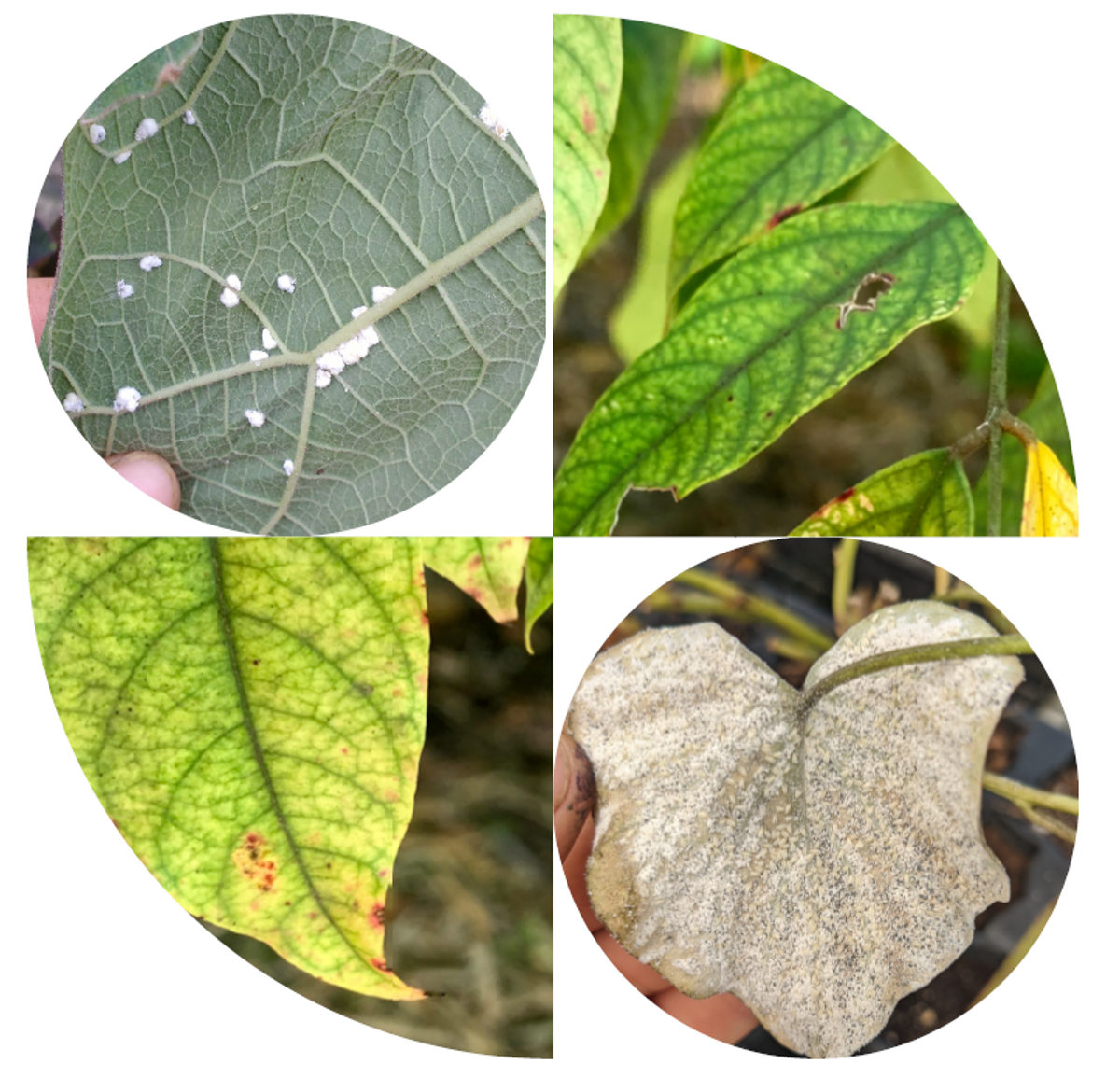ECHO quick photo guide of insect pest damage vs. other crop damage
Last updated April 2021 by ECHO Staff
Chewing Insect Damage
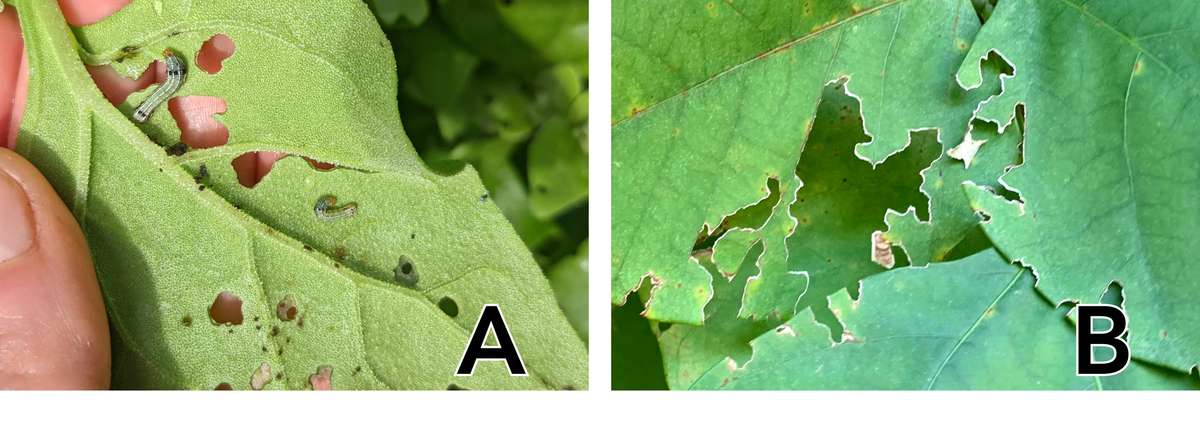 Chewing insects include caterpillars (immature lepidoptera), grasshoppers and crickets
Chewing insects include caterpillars (immature lepidoptera), grasshoppers and crickets
(orthoptera), and beetles and weevils (coleoptera). Photo A is southern armyworm on New Zealand spinach. Notice how most of the chewing occurs first on the interior of the leaf between leaf veins. Photo B is damage caused by adult Sri Lankan weevils. Notice how the chewing occurs from the outside of the leaf margin into the center. Eating patterns can be helpful in determining what order of pest you may have if they are not present. Grasshoppers and crickets prefer grass crops and typically chew from the outside of the leaf margin towards the center.
Piercing-Sucking Insect Damage
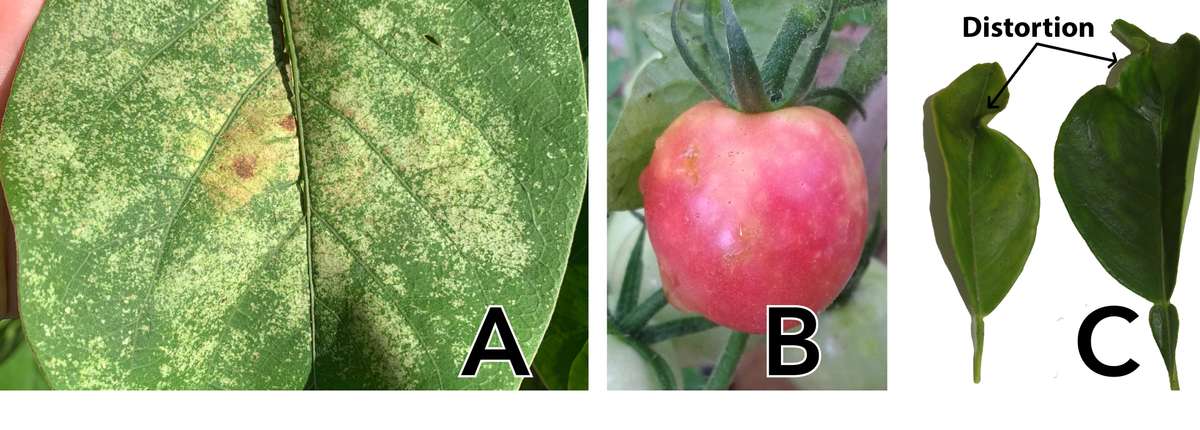 Piercing-sucking insects most frequently discolor leaf, fruit, or stem material, making them look mottled (A, lace bug damage on jack bean and B, leaffooted bug damage on tomatoes). This is easily confused with symptoms caused by viral infections, some fungal infections, as well as some nutrient deficiencies. These pests can also cause leaf die-back which results in brown spots that can be confused with fungal or bacterial diseases. Some piercing-sucking insects can also cause leaf deformities. Asian citrus psyllids, for example, cause citrus leaves to pinch inward (C). Piercing-sucking insects prefer the underside of leaves because the leaf surface is more tender and easier to pierce. Therefore, check the underside of leaves for these types of insects.
Piercing-sucking insects most frequently discolor leaf, fruit, or stem material, making them look mottled (A, lace bug damage on jack bean and B, leaffooted bug damage on tomatoes). This is easily confused with symptoms caused by viral infections, some fungal infections, as well as some nutrient deficiencies. These pests can also cause leaf die-back which results in brown spots that can be confused with fungal or bacterial diseases. Some piercing-sucking insects can also cause leaf deformities. Asian citrus psyllids, for example, cause citrus leaves to pinch inward (C). Piercing-sucking insects prefer the underside of leaves because the leaf surface is more tender and easier to pierce. Therefore, check the underside of leaves for these types of insects.
Viral Disease Symptoms
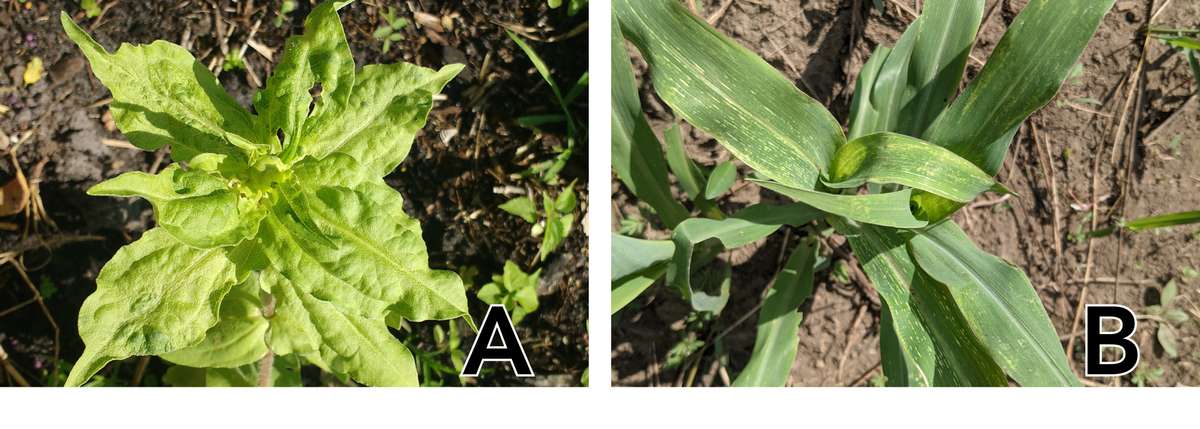 Viral disease can look like almost any other disease or damage. Viral infection symptoms such as leaf curling and bubbling (A, in zinnias) are commonly confused with piercing-sucking insect damage. Discolorations/mottling on the leaf surface is another viral infection symptom (B, maize chlorotic mottle virus) that can easily be confused with plant nutrient deficiencies.
Viral disease can look like almost any other disease or damage. Viral infection symptoms such as leaf curling and bubbling (A, in zinnias) are commonly confused with piercing-sucking insect damage. Discolorations/mottling on the leaf surface is another viral infection symptom (B, maize chlorotic mottle virus) that can easily be confused with plant nutrient deficiencies.
Bacterial Disease Symptoms
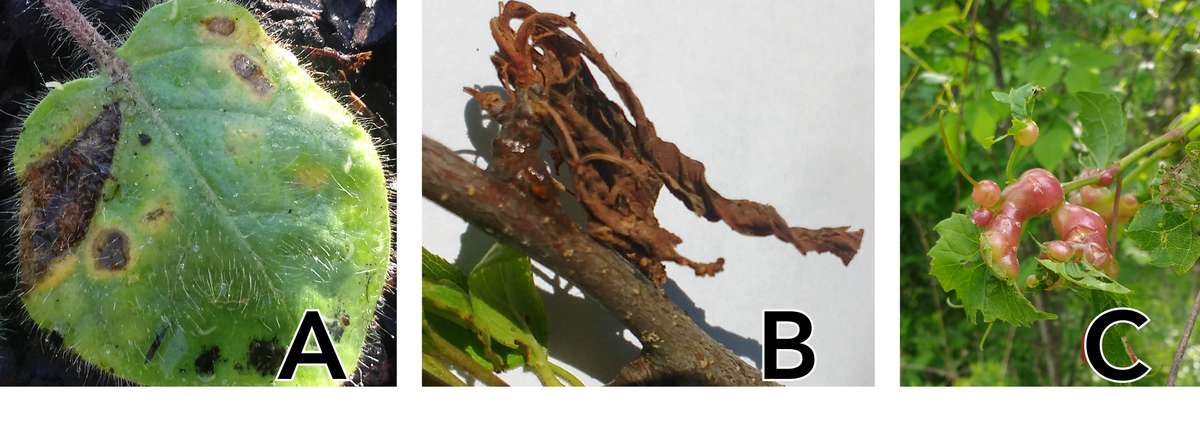 Bacterial diseases are often difficult to diagnose as they look very similar to fungal diseases. One of the main distinguishing features is that bacterial spots usually have a yellow halo (A, on naranjilla) around the outside of the spot. As the tissue within the spot dies, it can fall out creating a shothole-pattern that looks very similar to chewing insect feeding. Bacteria also causes plant symptoms such as cankers (B, on plum tree), galls, or spots that look wet or oily. Galls can be caused by insect damage such as in C, mite feeding causing galls on grapes, or by bacteria or viruses. Oozing plant sap can also indicate a bacterial infection in some situations.
Bacterial diseases are often difficult to diagnose as they look very similar to fungal diseases. One of the main distinguishing features is that bacterial spots usually have a yellow halo (A, on naranjilla) around the outside of the spot. As the tissue within the spot dies, it can fall out creating a shothole-pattern that looks very similar to chewing insect feeding. Bacteria also causes plant symptoms such as cankers (B, on plum tree), galls, or spots that look wet or oily. Galls can be caused by insect damage such as in C, mite feeding causing galls on grapes, or by bacteria or viruses. Oozing plant sap can also indicate a bacterial infection in some situations.
Fungal Disease Symptoms
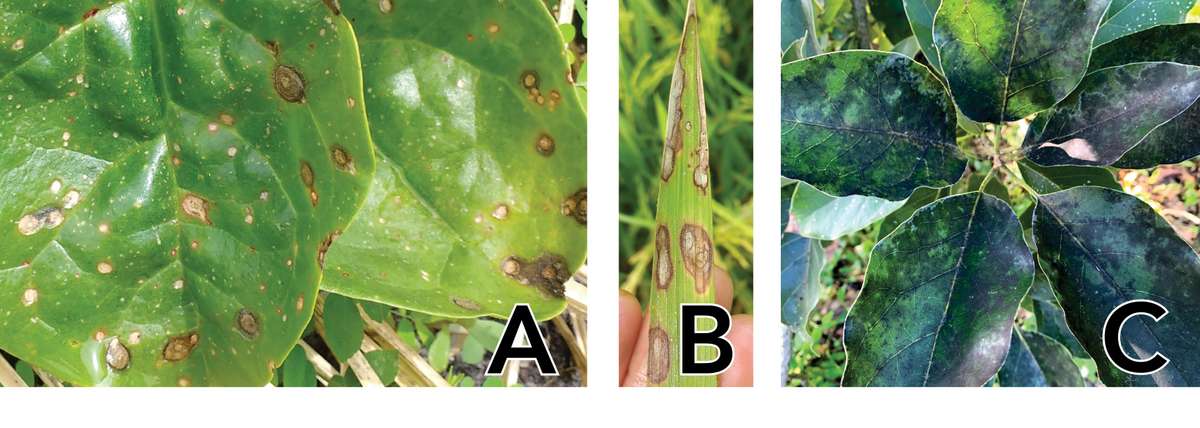 Fungal diseases often appear as spots similar to bacterial spots, but they typically do not look wet and often have distinctive concentric rings (A & B). Fungi can also cause damping off, where stems of newly emerging seedlings and young transplants collapse inward and cause the plant to fall over and die. Some piercing-sucking insects such as aphids, secrete a sugary substance that can encourage the growth of some fungi such as sooty mold on the leaf surface (C), limiting photosynthesis.
Fungal diseases often appear as spots similar to bacterial spots, but they typically do not look wet and often have distinctive concentric rings (A & B). Fungi can also cause damping off, where stems of newly emerging seedlings and young transplants collapse inward and cause the plant to fall over and die. Some piercing-sucking insects such as aphids, secrete a sugary substance that can encourage the growth of some fungi such as sooty mold on the leaf surface (C), limiting photosynthesis.
Nutrient Deficiency Symptoms
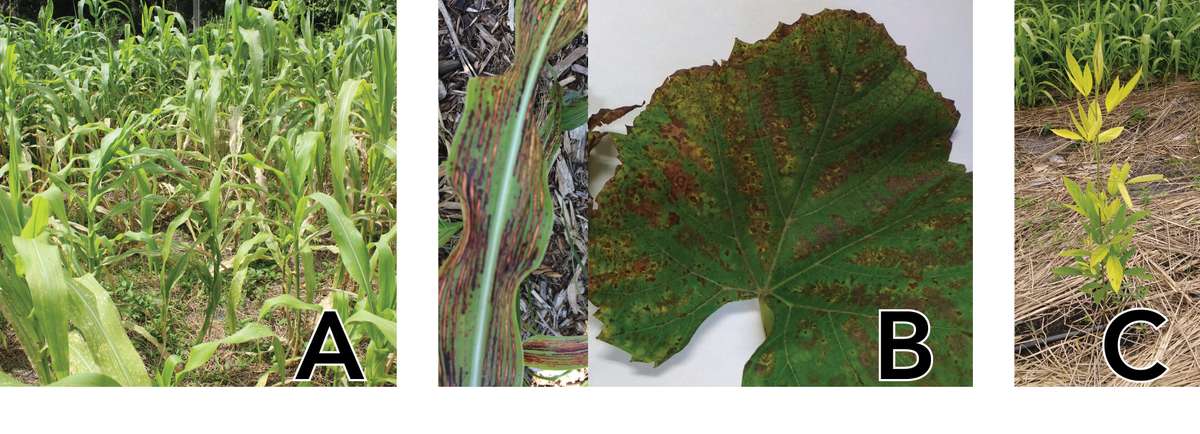 Nutrient deficiency symptoms in plant tissues can often be confused with pest damage (A, nitrogen deficiency in carambola; B, magnesium deficiency in sorghum and Cucurbita; and C, sulfur deficiency in pigeon pea). Lack of nutrient availability or access (due to pH or soil texture) cause discolorations or other changes in plant appearance that are unrelated to pest damage. For more information about diagnosing nutrient deficiencies in the field, see Asia Note #29 http://edn.link/drjqee.
Nutrient deficiency symptoms in plant tissues can often be confused with pest damage (A, nitrogen deficiency in carambola; B, magnesium deficiency in sorghum and Cucurbita; and C, sulfur deficiency in pigeon pea). Lack of nutrient availability or access (due to pH or soil texture) cause discolorations or other changes in plant appearance that are unrelated to pest damage. For more information about diagnosing nutrient deficiencies in the field, see Asia Note #29 http://edn.link/drjqee.
Similar Symptoms, Different Culprits
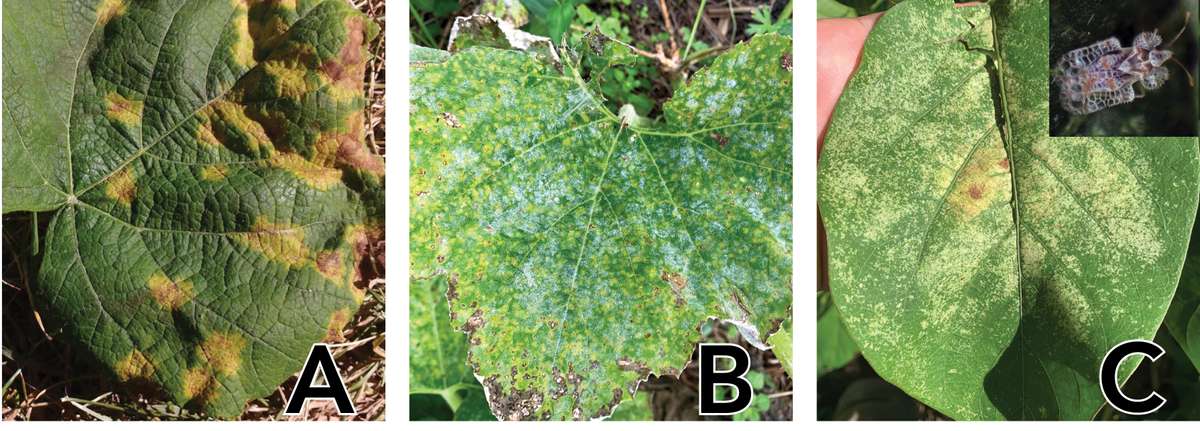 Leaf symptoms of fungal diseases, such as downy mildew (A) and powdery mildew (B), can look similar to damage from piercing-sucking insects. Downy mildew is restricted by leaf veins, giving it a blocky appearance with white fungal growth on the underside of the leaf. Powdery mildew has small circular discolorations across the whole leaf surface, often forming white spores on either surface of the leaf. Either of these can be confused with damage from piercing-sucking insects (C, lace bug damage on jack bean with lace bug photo inset), which cause pin-point discoloration where they have fed on the underside of the leaf. This can lead to brown necrotic spots that look similar to downy mildew.
Leaf symptoms of fungal diseases, such as downy mildew (A) and powdery mildew (B), can look similar to damage from piercing-sucking insects. Downy mildew is restricted by leaf veins, giving it a blocky appearance with white fungal growth on the underside of the leaf. Powdery mildew has small circular discolorations across the whole leaf surface, often forming white spores on either surface of the leaf. Either of these can be confused with damage from piercing-sucking insects (C, lace bug damage on jack bean with lace bug photo inset), which cause pin-point discoloration where they have fed on the underside of the leaf. This can lead to brown necrotic spots that look similar to downy mildew.
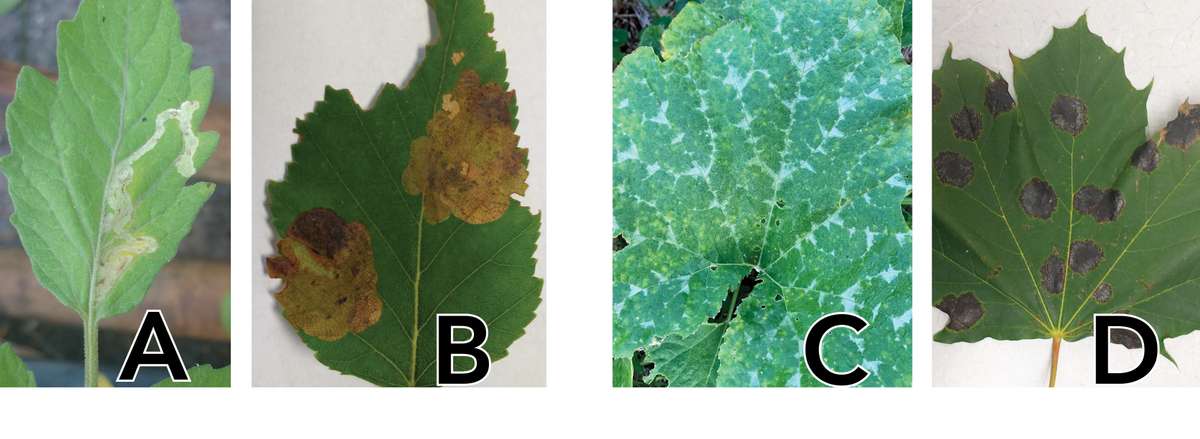 Leafminers are small insects in multiple orders that feed within the leaf tissue (A, on tomato and B, on linden). They can cause blotchy patches on leaves that die. This damage can look very similar to many leaf fungal diseases (C, fungus on Cucurbita and D, tar spot on maple), however, they can be often be easily identified by carefully pulling back the top layer of the damaged leaf blotch. If it is leafminer damage, the dead section will be hollow, and often insect frass or shed skins can be found inside.
Leafminers are small insects in multiple orders that feed within the leaf tissue (A, on tomato and B, on linden). They can cause blotchy patches on leaves that die. This damage can look very similar to many leaf fungal diseases (C, fungus on Cucurbita and D, tar spot on maple), however, they can be often be easily identified by carefully pulling back the top layer of the damaged leaf blotch. If it is leafminer damage, the dead section will be hollow, and often insect frass or shed skins can be found inside.
 Damage from mites, such as spider mites (A, on brachiaria) can be easily mistaken for nitrogen deficiency (B, in carambola) or sulfur deficiency (C, in pigeon pea). A hand lens or microscope can aid in determining if mites are present on the leaf surface. Nutrient deficiencies will often follow set patterns either affecting only old or new leaves or have a uniform pattern of necrosis around leaf edges, leaf tips, or yellowing between leaf veins.
Damage from mites, such as spider mites (A, on brachiaria) can be easily mistaken for nitrogen deficiency (B, in carambola) or sulfur deficiency (C, in pigeon pea). A hand lens or microscope can aid in determining if mites are present on the leaf surface. Nutrient deficiencies will often follow set patterns either affecting only old or new leaves or have a uniform pattern of necrosis around leaf edges, leaf tips, or yellowing between leaf veins.
 Herbicide drift (A, on winter wheat) can look similar to fungal diseases (B, on rice) or magnesium deficiency (C, in sorghum). If your field is located near fields that receive herbicides, noticing damage in a uniform pattern along a field edge can indicate spray drift.
Herbicide drift (A, on winter wheat) can look similar to fungal diseases (B, on rice) or magnesium deficiency (C, in sorghum). If your field is located near fields that receive herbicides, noticing damage in a uniform pattern along a field edge can indicate spray drift.
This issue is copyrighted 2021. All photos were taken by ECHO Staff. ECHO is a non-profit Christian organization. For further resources, including the opportunity to network with other agricultural and community development practitioners, please visit our website: www.ECHOcommunity.org.
